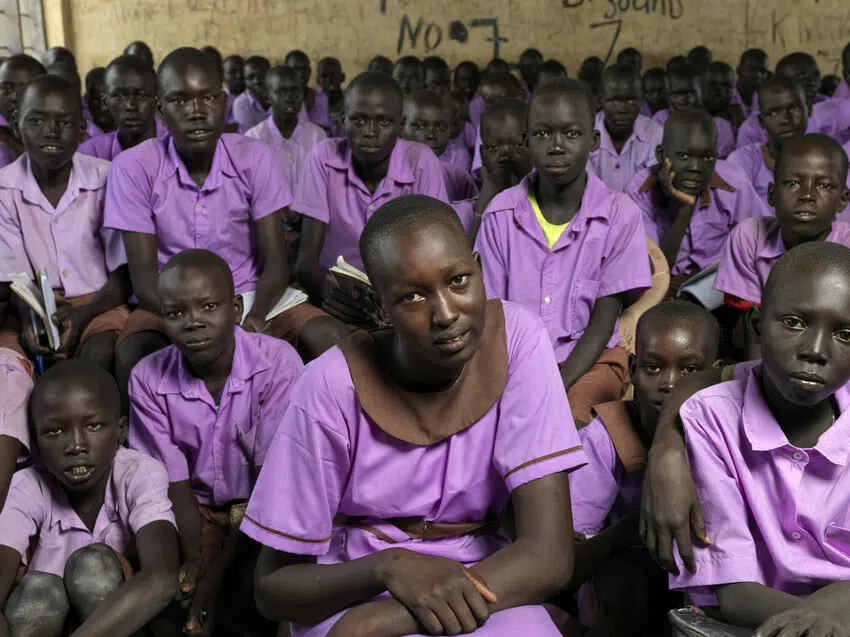Media Centre - 18 August 2022
Starved of a future: new report lays bare the shocking impact of global food crisis on children, girls and vulnerable groups

A new interactive report released today by humanitarian organisation Plan International Australia has underscored the staggering and disproportionate impact of the global hunger crisis on the world’s most vulnerable groups, revealing soaring rates of child marriage, heightened food insecurity amongst disabled communities and shocking statistics on the amount of children facing malnutrition, stunting and death.
The research found that the equivalent of 24 children – a typical Australian school class – die every three and a half minutes of hunger-related causes. Between school starting at 9am and recess at 11.30am, the equivalent of 60 classrooms will die of starvation.
An estimated 45 million children under the age of five currently suffer from wasting, the deadliest form of malnutrition, which increases children’s risk of death by up to 12 times.
Plan International Australia is calling for urgent support from the Australian Government in the form of a $150m Famine Prevention Package to avert the worst impacts of this crisis and prevent the deaths of thousands of children.
In Somalia, where food shortages and drought have this year killed millions of livestock and caused crops to fail, the UN has warned eight regions could see famine in a matter of weeks. It is feared that by the end of this year, 1.5 million Somalian children under the age of five will be acutely malnourished, including 380,000 who are likely to be severely malnourished.
In South Sudan – one of the six countries most at risk of famine, with 7.2 million people (60% of the population) in food crisis – over 2 million people are at risk of famine if they do not receive immediate assistance and 1.4 million children are already suffering from acute malnutrition. The country is facing multiple humanitarian crises, with the country affected by years of conflict and a vicious cycle of drought and flooding.
The worsening situation in South Sudan has been compounded by recent funding cuts which have meant that essential food support programs have been scaled back. Humanitarian agencies are being forced to make impossible decisions to allocate funding to the starving over the hungry – leaving 1.7 million hungry people who were recipients of food aid in South Sudan on the brink of famine.
The report also highlights the heightened risks facing young women and girls who are food insecure. Of the 690 million people who are food insecure in the world today, 60% are women and girls – that’s more than 16 times the population of Australia. In times of crisis, girls are the first to be taken out of school and the last to be fed when food runs low.
Child marriage is further fuelled by crises such as hunger and starvation. In South Sudan, a Plan International assessment found that 4 million girls have been affected by early or forced marriage so far in 2022, an increase from 2.7 million in all of 2021. More than half of all girls in South Sudan are married before they turn 18.
Girls are also caught in a double crisis of hunger and violence in many places. In a recent needs assessment of 635 people in Somalia, girls and women interviewed said rape and other forms of sexual and gender-based violence were rising as food insecurity worsened. A third (34%) of people surveyed believe security risks – including rape, domestic violence, female genital mutilation (FGM) and child marriage – to girls and women have increased as a result of the drought.
One 13-year-old girl living in Somalia told Plan International that her biggest fear is being sent to the city to work or being married off in exchange for money: “Whenever I see a man speaking with my mother, I get scared thinking that I am the deal.”
The child rights’ organisation has also spoken to girls in Kenya, some as young as 11 or 12, saying they are being exploited by older men in exchange for food, water or money. One 15-year-old from Kenya said: “This year has been the toughest year ever for girls as the lack of water and food makes some girls offer sexual activities in exchange for sanitary pads, food and clean water.”
People with disabilities also experience a greater risk of malnutrition and food insecurity. More than a third 36% of people or households with disabilities do not always have food to eat, compared to 23% of people or households without disabilities. Where food assistance programs exist, information may not be accessible nor disseminated to persons with disabilities.
Due to the severity of the global hunger situation, Plan International has declared the Hunger Crisis as a Red Alert Level emergency. Focusing on eight priority countries: Kenya, Ethiopia, Somalia, South Sudan, Mali, Burkina Faso, Niger and Haiti, hunger is now the number one priority for the organisation.
“Where is the shock, where is the outrage and most importantly where is the action,” said Plan International Australia CEO Susanne Legena.
“We are really at the tipping point for famine and if the world does not urgently step up life-saving humanitarian assistance, we are going to see a lot of death.
“Covid-19, climate change and conflict, particularly in Ukraine, have converged and created a terrifying situation. In its first year alone, the pandemic pushed an additional 300 people worldwide into hunger every minute. Meanwhile, Increasing greenhouse gas emissions are damaging essential food crops such as maize and wheat.
“We are already seeing 24,000 people a day die of starvation – horrifyingly, experts are projecting that number to climb to 300,000 people starving to death every single day if we do not take action now. Humanitarian organisations are facing an impossible choice between feeding the hungry and feeding the starving. We must act, and we must act now.
[ENDS]
Notes to editors:
- Full PDF version of Running on Empty, including additional interviews and findings, can be found here.
- A total of 635 people participated in the Plan International needs assessment in Somalia, including 330 women, 146 men, 95 girls, and 64 boys. 263 respondents were in Togdheer, 148 in Sool and 224 in Sanaag region. In Togdheer, more than half (54%) of respondents had crossed into the country from Ethiopia.
- Plan International is working in many of the countries bearing the brunt of this global food crisis. We are rapidly scaling up programmes such as cash and voucher assistance, food distributions, school meals, malnutrition screening and nutrition support. In South Sudan we are scaling up our food distributions in partnership with the World Food Programme, providing lifesaving supplementary feeding to pregnant and lactating mothers and children under five.
- Where possible across our food response programs we are providing cash or vouchers so families are able to buy food themselves so girls do not drop out of school to support families either by working or by looking after siblings. Where schools have closed, we are adapting and increasing school feeding programs so children are still able to eat when at home, allowing them more time to continue studying remotely where possible.
- We are scaling up protection mechanisms at the community level to respond to the increase in protection and child protection concerns and where we are distributing food directly, we are ensuring a protective environment for women and girls.
Media contacts

